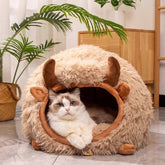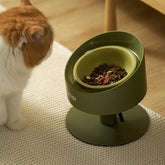Dental problems with cats and how to avoid them

There are numerous causes of dental problems in cats, but the most common is a lack of calcium or other minerals. Tartar builds up on their teeth because of improper brushing or not brushing at all. You may not be capable of telling if your cat is suffering from oral health issues simply by looking at them — and by the time you do notice something is wrong, it may be too late to prevent it. Dental care is critical for the health of your cat. It is critical for our pets, but they require our assistance.
Poor dental hygiene affects their overall health, including their teeth, gums, and mouth. The following are signs and symptoms of feline dental disease:
- Bad odor
- Visible tartar or tooth discoloration
- Tooth roots that protrude
- Biting one's nails or pawing at one's teeth
- Inflamed, swollen, or bleeding gums
- Possible bloody drooling
- Less frequent grooming
- Eating problems
- Weight loss
Periodontal disease, gingivitis, and tartar accumulation
Dental plaque and tartar build-up in cats, just like they do in humans. Plaque and tartar accumulation rates in cats vary dramatically and are controlled by several factors, including heredity and food. Plaque and tartar buildup cause gingivitis, which can lead to periodontal disease if left untreated.
Home oral care can help delay the process, but no matter how much teeth brushing or other at-home oral care can eliminate it. It is for this reason that people get dental cleanings once every six months. Cats behave similarly. Regular professional dental cleanings are beneficial to those who have tartar and gingivitis.
Dental Trauma
Broken teeth are common in cats and a common source of discomfort and illness that goes unnoticed. A pulp fracture will invariably result in infection and pulp tissue death. One of the root canals or extraction should be used to treat a cracked tooth in the pulp cavity.
Many cracked teeth in cats are caused by resorption damage that weakens the tooth initially. The tooth is irreparably destroyed in these circumstances, and extraction is typically the best choice. Our cat will feel much better once these teeth are removed, and the ache begins to subside.
How to Help Prevent Dental Disease
Nutrition & Diet
The importance of diet in the fight against dental disease cannot be overstated. Your cat's general health will be protected by well-balanced, healthy cat food, which will enable it to fight diseases and aid in healing.
Some cat owners feel that kibble or hard food will offer the necessary abrasive action for their cat's teeth to be cleaned. This is not the case. Most cats swallow their food whole rather than chewing it. Manufacturers of cat food have come up with a variety of kibble forms to entice a cat to bite or chew, yet none of them clean the teeth well.
A Dental Care Routine at Home

Many cats dread having their jaws interfered with, but with time and treats, you may ease them into it. The earlier you start giving your cat dental care, the easier it will be.
Brushing your cat's teeth at least three times a week is the gold standard of preventative dental care.
-
A cat toothbrush, toothpaste (do not use human toothpaste because the fluoride in it is poisonous to cats), dental gauze, or a finger brush are all necessary.
-
Start cautiously and gradually adapt your cat to you, messing with his or her face and lips. Begin by softly rubbing around your cat's mouth, then attempt putting your finger between its lips and massaging or at least touching its gums once your cat is comfortable with it. You can rub your finger over your cat's teeth after they are comfortable with you touching their gums.
-
Toss in some yum: Now it's time to add the toothpaste. Cat toothpaste comes in two flavors: chicken and fish, and cats adore it. A dab on your finger is the finger brush. If your cat enjoys it, lightly massage it on the outside of his or her teeth.
-
Introduce the brush: Because cats enjoy chewing on bristles, you can give it to them with or without toothpaste to get them used to the texture and have it in their mouth. Chewing the bristles helps to eliminate plaque from the teeth.

After that, carefully press the toothpaste-coated toothbrush, finger brush, or gauze on the outside of your cat's teeth in small, slow circles. It should be a peaceful, soothing attempt to avoid anxiety in both you and your cat. Also, don't forget to massage your gums. If your cat is food motivated, dental treats and supplements with enzymes and chemicals that de-mineralize plaque and tartar will speed up the process.
Regular dental check-ups with your veterinarian will help you avoid significant teeth issues. When they get their yearly booster shot, it's an excellent time to do a check.























